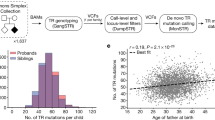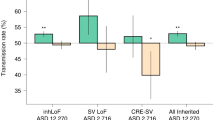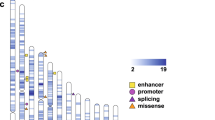Abstract
A polymorphic trinucleotide repeat (CGG/GCC) within the human Reelin gene (RELN) was examined as a candidate gene for autism spectrum disorders (ASDs). This gene encodes a large extracellular matrix protein that orchestrates neuronal positioning during corticogenesis. The CGG-repeat within the 5′ untranslated region of RELN exon 1 was examined in 126 multiple-incidence families. The number of CGG repeats varied from three to 16 in affected individuals and controls, with no expansion or contraction observed during maternal (n = 291) or paternal (n = 287) transmissions in families with autistic probands. Although the frequencies of the RELN alleles and genotypes in affected children were not different from those in the comparison group, a family-based association test (FBAT) showed that the larger RELN alleles (≥11 repeats) were transmitted more often than expected to affected children (S = 43, E(S) = 34.5, P = 0.035); this was particularly the case for the 13-repeat RELN allele (S = 22, E(S) = 16, P = 0.034). Affected sib-pair (ASP) analysis found no evidence of excess sharing of RELN alleles in affected siblings. The impact of genotypes with large alleles (≥11 repeats) on the phenotypes in individuals with ASD was analyzed by ANOVA in a subset of the families for which results of the Autism Diagnostic Interview-Revised were available. Children with large RELN alleles did not show any difference in scores for questions related to the core symptoms of autistic disorder, but there was a tendency for children with at least one large RELN allele to have an earlier age at first phrase (χ2 = 3.538, P = 0.06). Thus, although the case-control and affected sib-pair findings did not support a role for RELN in susceptibility to ASD, the more powerful family-based association study demonstrated that RELN alleles with larger numbers of CGG repeats may play a role in the etiology of some cases of ASD, especially in children without delayed phrase speech.
This is a preview of subscription content, access via your institution
Access options
Subscribe to this journal
Receive 12 print issues and online access
$259.00 per year
only $21.58 per issue
Buy this article
- Purchase on Springer Link
- Instant access to full article PDF
Prices may be subject to local taxes which are calculated during checkout
Similar content being viewed by others
References
Bailey A, Le Couteur A, Gottesman I, Bolton P, Simonoff E, Yuzda E et al. Autism as a strongly genetic disorder: evidence from a British twin study Psychol Med 1995 25: 63–77
Pickles A, Starr E, Kazak S, Bolton P, Papanikolaou K, Bailey A et al. Variable expression of the autism broader phenotype: findings from extended pedigrees J Child Psychol Psychiatry 2000 41: 491–502
Pickles A, Bolton P, Macdonald H, Bailey A, Le Couteur A, Sim CH et al. Latent-class analysis of recurrence risks for complex phenotypes with selection and measurement error: a twin and family history study of autism Am J Hum Genet 1995 57: 717–726
Risch N, Spiker D, Lotspeich L, Nouri N, Hinds D, Hallmayer J et al. A genomic screen of autism: evidence for a multilocus etiology Am J Hum Genet 1999 65: 493–507
Turner M, Barnby G, Bailey A . Genetic clues to the biological basis of autism Mol Med Today 2000 6: 238–244
D'Arcangelo G, Curran T . Reeler: new tales on an old mutant mouse Bioessays 1998 20: 235–244
D'Arcangelo G, Homayouni R, Keshvara L, Rice DS, Sheldon M, Curran T . Reelin is a ligand for lipoprotein receptors Neuron 1999 24: 471–479
Alcantara S, Ruiz M, D'Arcangelo G, Ezan F, de Lecea L, Curran T et al. Regional and cellular patterns of reelin mRNA expression in the forebrain of the developing and adult mouse J Neurosci 1998 18: 7779–7799
Pesold C, Impagnatiello F, Pisu MG, Uzunov DP, Costa E, Guidotti A et al. Reelin is preferentially expressed in neurons synthesizing gamma-aminobutyric acid in cortex and hippocampus of adult rats Proc Natl Acad Sci U S A 1998 95: 3221–3226
Costa E, Davis J, Grayson DR, Guidotti A, Pappas D, Pesold C . Dendritic spine hypoplasticity and downregulation of reelin and GABAergic tone in schizophrenia vulnerability Neurobiol Dis 2001 8: 723–742
Hong SE, Shugart YY, Huang DT, Shahwan SA, Grant PE, Hourihane JO et al. Autosomal recessive lissencephaly with cerebellar hypoplasia is associated with human RELN mutations Nat Genet 2000 26: 93–96
Impagnatiello F, Guidotti AR, Pesold C, Dwivedi Y, Caruncho H, Pisu MG et al. A decrease of reelin expression as a putative vulnerability factor in schizophrenia Proc Natl Acad Sci U S A 1998 95: 15718–15723
Guidotti A, Auta J, Davis JM, DiGiorgi GV, Dwivedi Y, Grayson DR et al. Decrease in reelin and glutamic acid decarboxylase67 (GAD67) expression in schizophrenia and bipolar disorder: a postmortem brain study Arch Gen Psychiatry 2000 57: 1061–1069
Kemper TL, Bauman M . Neuropathology of infantile autism J Neuropathol Exp Neurol 1998 57: 645–652
Ritvo ER, Freeman BJ, Scheibel AB, Duong T, Robinson H, Guthrie D et al. Lower Purkinje cell counts in the cerebella of four autistic subjects: initial findings of the UCLA-NSAC Autopsy Research Report Am J Psychiatry 1986 143: 862–866
Persico AM, D'Agruma L, Maiorano N, Totaro A, Militerni R, Bravaccio C et al. Reelin gene alleles and haplotypes as a factor predisposing to autistic disorder Mol Psychiatry 2001 6: 150–159
Fatemi SH . Reelin mutations in mouse and man: from reeler mouse to schizophrenia, mood disorders, autism and lissencephaly Mol Psychiatry 2001 6: 129–133
Grayson DR, Chen Y, Uzunov DP, Costa E . Molecular mechanisms regulating reelin gene expression Am J Med Genet 2000 565: (Abstract)
Fu YH, Kuhl DP, Pizzuti A, Pieretti M, Sutcliffe JS, Richards S et al. Variation of the CGG repeat at the fragile X site results in genetic instability: resolution of the Sherman paradox Cell 1991 67: 1047–1058
Horvath S, Xu X, Laird NM . The family based association test method: strategies for studying general genotype–phenotype associations Eur J Hum Genet 2001 9: 301–306
Yano H, Wang BE, Ahmad I, Zhang J, Abo T, Nakayama J et al. Identification of (CAG)(n) and (CGG)(n) repeat-binding proteins, CAGERs expressed in mature neurons of the mouse brain Exp Cell Res 1999 251: 388–400
Robinson PD, Schutz CK, Macciardi F, White BN, Holden JJ . Genetically determined low maternal serum dopamine beta-hydroxylase levels and the etiology of autism spectrum disorders Am J Med Genet 2001 100: 30–36
Lord C, Rutter M, Le Couteur A . Autism Diagnostic Interview-Revised: a revised version of a diagnostic interview for caregivers of individuals with possible pervasive developmental disorders J Autism Dev Disord 1994 24: 659–685
Lord C, Rutter M, Goode S, Heemsbergen J, Jordan H, Mawhood L et al. Autism diagnostic observation schedule: a standardized observation of communicative and social behavior J Autism Dev Disord 1989 19: 185–212
Geschwind DH, Sowinski J, Lord C, Iversen P, Shestack J, Jones P et al. The autism genetic resource exchange: a resource for the study of autism and related neuropsychiatric conditions Am J Hum Genet 2001 69: 463–466
Holden JJ, Chalifoux M, Wing M, Julien-Inalsingh C, White BN . A rapid, reliable, and inexpensive method for detection of di- and trinucleotide repeat markers and disease loci from dried blood spots Am J Med Genet 1996 64: 313–318
Ott J . Analysis of Human Genetic Linkage John Hopkins University Press: Baltimore, MA 1999
Sham PC, Curtis D . Monte Carlo tests for associations between disease and alleles at highly polymorphic loci Ann Hum Genet 1995 59 (Pt 1): 97–105
Acknowledgements
The authors are very grateful to the families who participated in this research and we acknowledge the resources provided by the AGRE (Autism Genetics Resource Exchange) consortium (www.AGRE.org) and the participating AGRE families. We also thank The Autism Research Consortium and the ‘Think-Tank’ session members who led to the current study (Director: Margaret Bauman, MD, Massachusetts General Hospital. Members: George M Anderson, PhD, Yale University School of Medicine; Gene Blatt, PhD, Boston University School of Medicine; Edwin H Cook, MD, University of Chicago; Jeanette JA Holden, PhD, Queen's University, Ontario; Thomas L Kemper, MD, Boston University School of Medicine; Marcie MacDonald, PhD, Massachusetts General Hospital; Francesca Persichetti, PhD, Massachusetts General Hospital; Jonathan LR Rubenstein, PhD, Univ of California at San Francisco; Stephen Vincent, PhD, Human Brain Tissue Resource Center; Gary L Wenk, PhD, The University of Arizona; Andrew Zimmerman, MD, Kennedy Krieger Institute & Johns Hopkins University.
This work was supported by research grants from the Ontario Mental Health Foundation (to JJAH) and the Canadian Institutes of Health Research Interdisciplinary Health Research Team grant RT-43820 to the Autism Spectrum Disorders Canadian-American Research Consortium (ASD-CARC) (JJAH, principal investigator; www.autismresearch.ca) and a scholarship from the Ontario Mental Health Foundation (to HZ).
Author information
Authors and Affiliations
Corresponding author
Rights and permissions
About this article
Cite this article
Zhang, H., Liu, X., Zhang, C. et al. Reelin gene alleles and susceptibility to autism spectrum disorders. Mol Psychiatry 7, 1012–1017 (2002). https://doi.org/10.1038/sj.mp.4001124
Received:
Revised:
Accepted:
Published:
Issue Date:
DOI: https://doi.org/10.1038/sj.mp.4001124
Keywords
This article is cited by
-
Bio-collections in autism research
Molecular Autism (2017)
-
The Neurobiological Basis for Social Affiliation in Autism Spectrum Disorder and Schizophrenia
Current Behavioral Neuroscience Reports (2016)
-
Nicotine exposure during adolescence: cognitive performance and brain gene expression in adult heterozygous reeler mice
Psychopharmacology (2014)
-
Epigenetic Factors and Autism Spectrum Disorders
NeuroMolecular Medicine (2013)



